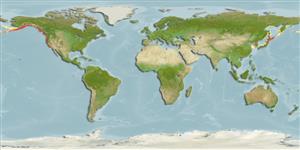>
Perciformes/Cottoidei (Sculpins) >
Rhamphocottidae (Grunt sculpins)
Etymology: Rhamphocottus: Greek, rhamphos = bill, peak + Greek, kottos = a fish without identificaction (Ref. 45335).
Eponymy: Sir John Richardson (1787–1865) was a Scottish naval surgeon, naturalist and Arctic explorer. [...] (Ref. 128868), visit book page.
More on author: Günther.
Environment: milieu / climate zone / depth range / distribution range
Ekologi
laut dasar (demersal); kisaran kedalaman 0 - 165 m (Ref. 2850). Temperate; 66°N - 32°N
North Pacific: Japan to Alaska and at least Santa Monica Bay, southern California, USA.
Size / Weight / umur
Maturity: Lm ? range ? - ? cm
Max length : 8.9 cm TL jantan/; (Ref. 48784)
deskripsi pendek
Kunci identifiaksi (pengenalan) | Morfologi | Morfometrik
Duri punggung (Keseluruhan (total)) : 7 - 8; duri punggung lunak (Keseluruhan (total)) : 12 - 13; Duri dubur: 0; Sirip dubur lunak: 6 - 7. Caudal fin well rounded.
Inhabits intertidal areas and to 165 m depth, in tide pools and rocky areas but also sand bottoms (Ref. 2850). Frequently observed taking shelter in empty shells, including those of the giant barnacle, Balanus nubilis, and discarded bottles and cans (Ref. 48784). Young feed on zooplankton and invertebrate and fish larvae; adults feed also feed on crustaceans (Ref. 28499). May use its pectoral fins to crawl over rocks and seaweed (Ref. 6885).
A female chases a male into a rock crevice. She keeps him there until she lays her eggs (Ref. 28499).
Robins, C.R., R.M. Bailey, C.E. Bond, J.R. Brooker, E.A. Lachner, R.N. Lea and W.B. Scott, 1991. Common and scientific names of fishes from the United States and Canada. Am. Fish. Soc. Spec. Publ. (20):183 p. (Ref. 3814)
Status IUCN Red List (Ref. 130435: Version 2024-1)
ancaman kepada manusia
Harmless
penggunaan manusia
Perikanan: komersial; Akuarium: Akuarium publik
Alat, peralatan
laporan khas
muat turun XML
Sumber internet
Estimates based on models
Preferred temperature (Ref.
123201): 4.7 - 15.9, mean 8.9 °C (based on 558 cells).
Phylogenetic diversity index (Ref.
82804): PD
50 = 1.5000 [Uniqueness, from 0.5 = low to 2.0 = high].
Bayesian length-weight: a=0.01995 (0.00906 - 0.04395), b=3.01 (2.83 - 3.19), in cm total length, based on all LWR estimates for this body shape (Ref.
93245).
Trophic level (Ref.
69278): 3.4 ±0.37 se; based on food items.
Fishing Vulnerability (Ref.
59153): Low vulnerability (10 of 100).
